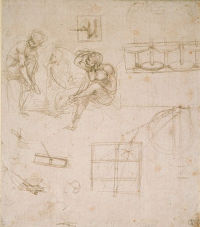The Body of Man Click on the thumbnails to explore the trail
Read more about this trail (expand)
According to Leonardo, man himself was at the centre of everything– “The measure of all things”. Throughout his life, the artist engaged in a dynamic and increasingly in-depth examination of man as a living organism, embarking on a seemingly unending quest to discover how man moved, grew, developed and perceived the world in which he lived.

- Enlarge
- Zoom & explore
- © Ashmolean Museum
Studies of figures and of machinery 1480-81
The representation of bodily movement was a particular challenge for all Renaissance artists who were keen to make their figures as lifelike as possible.
In this drawing, Leonardo explores bodily and mechanical movement in tandem. He uses silverpoint, the lines of which cannot be erased once they are laid down onto the prepared surface of the paper. The medium is handled with great confidence, indicating that Leonardo is well practiced in the technique.
On the upper left of the sheet, three figures are shown sitting or crouching as if engaged in lively conversation. Leonardo perfectly captures the speed and spontaneity of their actions. The shifting, changing contours of the figures provides them with a lively sense of animation. Rapid diagonal hatching has been applied to model the forms of the figures and convey their anatomical structure.
Across the remainder of the sheet, Leonardo has sketched machine parts based on drawings after Brunelleschi’s devices for the construction of the dome and lantern of Florence Cathedral. The switch from thinking about the movements of men to those of machines or vice versa was a natural transition in Leonardo’s mind.
In Leonardo's words
…Observe and consider the positions and actions of men in talking, debating, or laughing, or fighting together, what actions there might be among them, what actions there might be among bystanders, among the participants, and among those who look on. And take note of them with slight strokes thus, in a little sketchbook, which you should always carry with you. And it should be of paper that is prepared in colour, so that it may not be rubbed out.
In this drawing, Leonardo explores bodily and mechanical movement in tandem.
On the upper left of the sheet, three figures are shown sitting or crouching as if engaged in lively conversation. Leonardo perfectly captures the speed and spontaneity of their actions with the fluid lines of the silverpoint. The shifting, changing, contours of each figure provides a sense of lively animation, while the assured handling of the silverpoint and rapid diagonal hatching articulates the bodily forms and conveys an intuitive grasp of their anatomical structure.
Across the remainder of the sheet, Leonardo has sketched machine parts based on drawings after Brunelleschi’s devices for the construction of the dome and lantern of Florence Cathedral, indicating an interest on the artist’s part in early mechanical inventions.
- Medium Silverpoint on pale ink prepared paper
- Size 20.4 x 18 cm
- Location Ashmolean Museum










